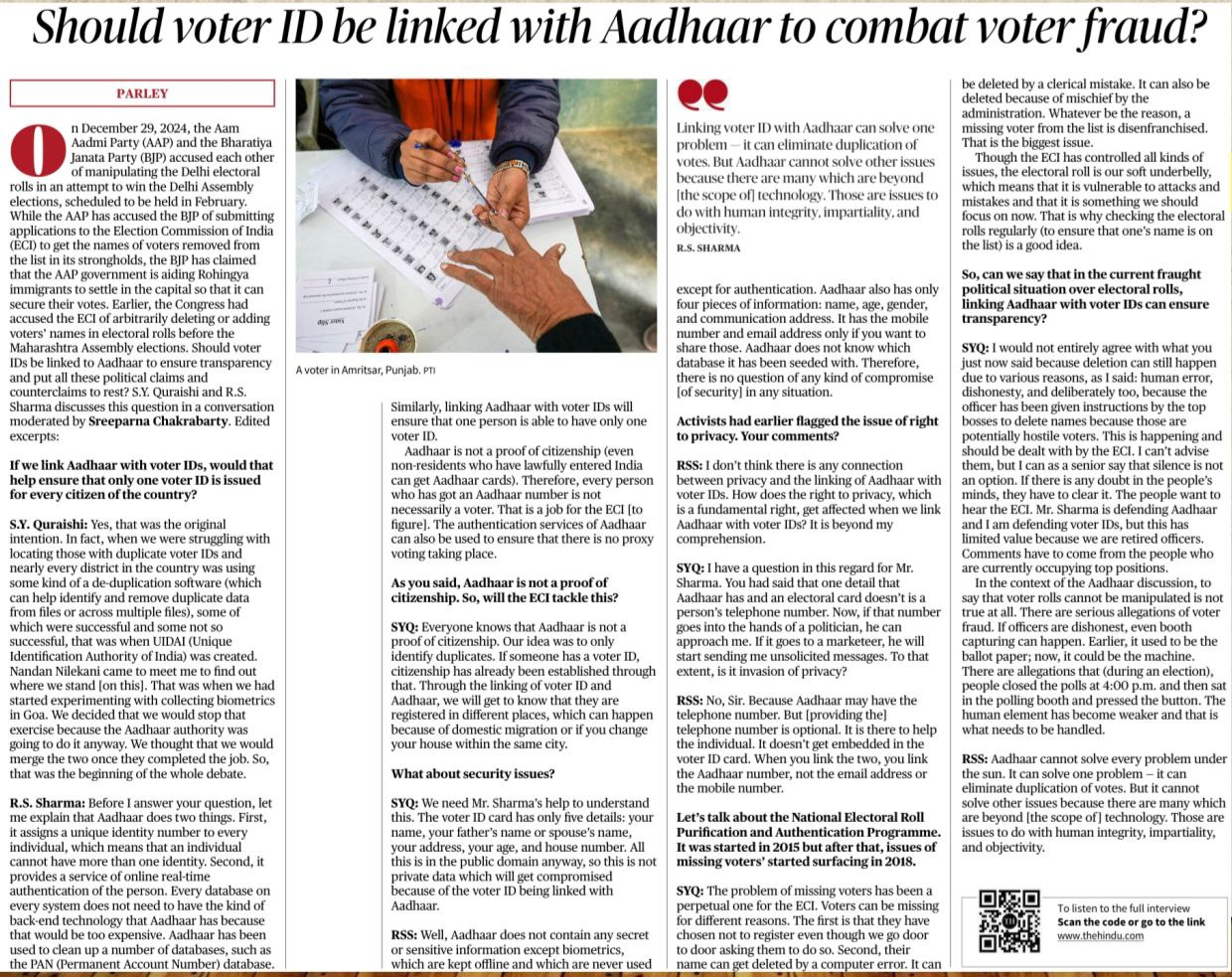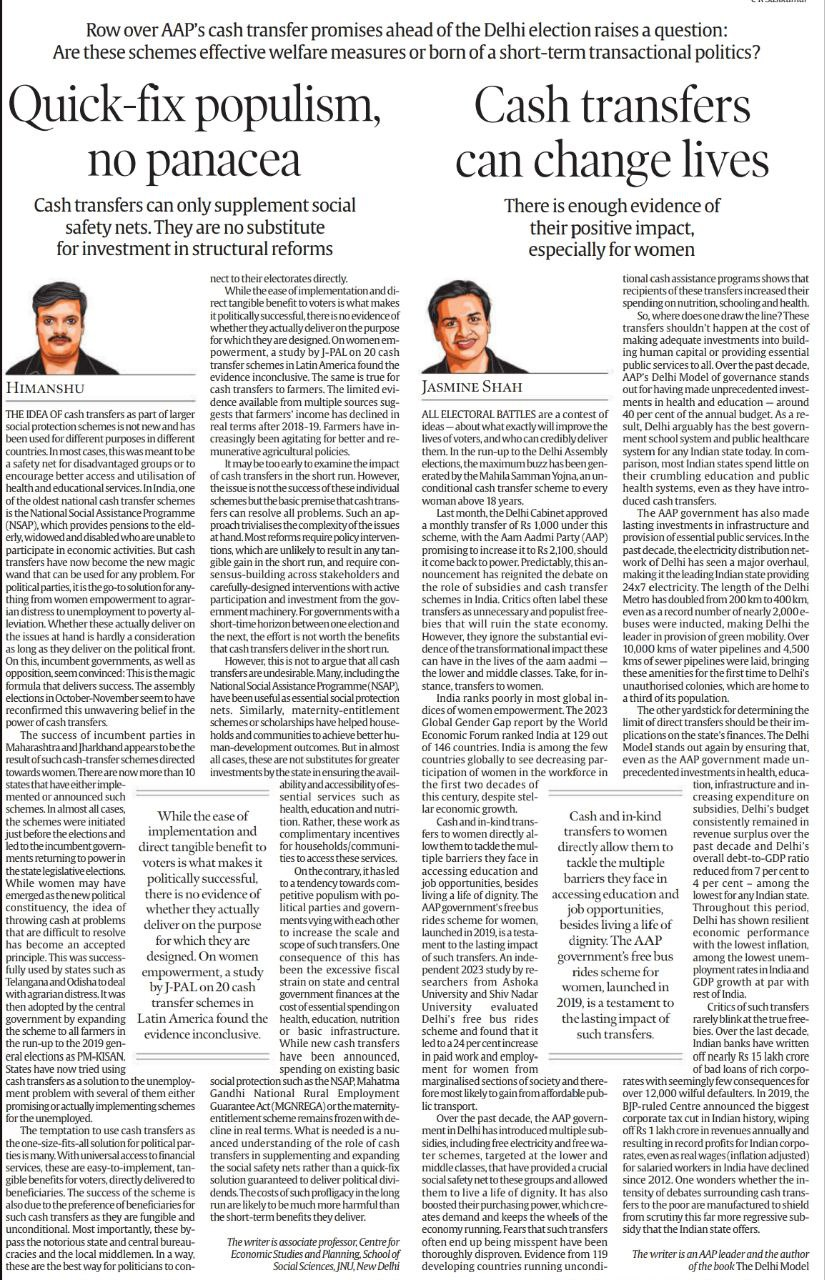1. Should Voter ID Be Linked with Aadhaar to Combat Electoral Fraud?
Introduction
Electoral integrity is a cornerstone of democracy. Recent allegations of voter fraud and manipulation have reignited the debate on whether linking Aadhaar with voter IDs could enhance transparency and eliminate malpractices. This topic examines the implications of such a move, balancing arguments on efficiency, security, and privacy.
Arguments in Favor of Linking Aadhaar with Voter IDs
- Eliminating Duplication:
- Ensures that one person is issued only one voter ID.
- De-duplication software can identify and remove redundant or fake voter entries.
- Curbing Electoral Malpractices:
- Mitigates risks of fraudulent voting by ensuring an updated and authentic voter database.
- Addresses issues of non-residents voting unlawfully.
- Enhanced Administrative Efficiency:
- Aadhaar-based identification simplifies voter verification at polling booths.
- Reduces manual errors in voter list maintenance.
Challenges in Linking Aadhaar with Voter IDs
- Privacy Concerns:
- Aadhaar contains sensitive personal data (e.g., mobile number and address) that raises fears of misuse.
- Activists argue that it infringes on the fundamental right to privacy.
- Possibility of Deletion Errors:
- Mistakes during data linking could disenfranchise genuine voters.
- Human or technical errors may lead to eligible voters being excluded.
- Aadhaar’s Limited Role as Proof of Citizenship:
- Aadhaar issuance does not establish citizenship, as it is provided to all residents, including non-citizens.
Past Measures and Concerns
- The National Electoral Roll Purification and Authentication Programme (NERPAP) initiated in 2015 aimed to link Aadhaar with voter IDs but faced opposition due to privacy and exclusion concerns.
- Allegations of bias in voter list updates, particularly by political parties, have eroded trust in the process.
Conclusion
Linking voter ID with Aadhaar has the potential to streamline voter registration and reduce duplication. However, addressing privacy issues and ensuring no eligible voter is excluded are critical. A balanced approach involving robust safeguards and transparent oversight is necessary to uphold democratic principles.
Mains Practice Question |
Q. Do you think linking Aadhaar with voter IDs is a viable solution to combat electoral fraud in India? Critically analyze the implications of this move in terms of transparency, privacy, and inclusivity. |
2. The Debate on Cash Transfers: Welfare Measure or Political Tool?
Introduction
- Cash transfers, often seen as a solution to a wide range of social and economic issues, have become a hallmark of political promises in India.
- As part of the larger discussion on social protection and welfare, these direct transfers are promoted as remedies for poverty, unemployment, women’s empowerment, and agrarian distress.
- However, their effectiveness and long-term sustainability have sparked intense debate. Are cash transfers genuinely beneficial welfare initiatives, or are they simply short-term political tactics designed to secure electoral gains?
- The Political Appeal of Cash Transfers
- Politicians, especially in election seasons, have increasingly turned to cash transfer schemes as a key strategy to appeal to voters. These schemes are seen as easy to implement, offering immediate, tangible benefits to voters. In states like Maharashtra, Jharkhand, Telangana, and Odisha, cash transfers have been instrumental in securing re-election victories. The simplicity and direct impact of cash transfers make them a popular choice for politicians aiming to deliver quick relief to voters.
- However, this focus on short-term electoral benefits raises concerns about the effectiveness of such schemes in addressing deeper, systemic issues. Cash transfers are often deployed as solutions for complex issues like agrarian distress, unemployment, and poverty alleviation, but the question remains whether these schemes provide lasting solutions or simply serve as political tools.
- Evidence of Success and Limitations
- While cash transfers have shown promise in specific contexts, such as targeted social welfare schemes like the National Social Assistance Programme (NSAP), their broad application remains controversial. For instance, studies on cash transfers for women empowerment have yielded mixed results. Though these transfers help empower women by providing them with financial independence, studies suggest that the overall impact on women’s long-term economic participation remains unclear.
- In the case of agriculture, cash transfers have not significantly alleviated farmer distress. Reports show that farmers’ incomes have declined in real terms despite cash transfer schemes. These observations highlight the limitations of cash transfers as standalone solutions, particularly in sectors that require comprehensive policy reforms and long-term investments.
- Sustainable Development and Investment in Infrastructure
- While cash transfers may provide immediate relief, they cannot replace the need for structural reforms in areas like education, healthcare, and infrastructure. The Delhi Model of governance, led by the Aam Aadmi Party (AAP), stands out as an example of a balanced approach. AAP has made substantial investments in education and healthcare, leading to tangible improvements in public services. Over the past decade, Delhi has transformed its healthcare and education systems, making them models for other states.
- Moreover, targeted schemes like free bus rides for women have not only empowered women but also contributed to increasing their participation in the workforce. Such schemes, when coupled with investments in infrastructure and essential public services, ensure that cash transfers complement long-term development efforts rather than replace them.
- Financial Sustainability
Critics argue that cash transfer schemes strain state finances. However, the AAP government’s experience shows that it is possible to implement such schemes without compromising fiscal health. Despite significant investments in social welfare, Delhi has managed to maintain a revenue surplus and a low debt-to-GDP ratio. This suggests that with prudent fiscal management, cash transfers can coexist with essential investments in public services and infrastructure.
Conclusion
Cash transfers have the potential to provide immediate relief to vulnerable populations and address short-term crises.
However, their effectiveness as a long-term welfare strategy remains debated. To ensure that these transfers lead to meaningful improvements in people’s lives, they must be part of a larger, more comprehensive approach that includes investments in education, healthcare, and infrastructure.
Policymakers must strike a balance between offering direct financial support and investing in systemic reforms that foster sustainable development.
The key challenge lies in avoiding the temptation of populism and ensuring that cash transfers do not become tools for short-term political gain, but rather supplements to a broader social safety net.
Mains Practice Question
|
Q1. Cash transfers are often hailed as a solution to various socio-economic issues in India. However, their effectiveness in the long run remains controversial. Discuss the pros and cons of cash transfer schemes and their implications on India’s welfare system. (250 words)
|



